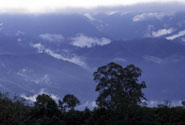Lorentz National Park: Papua
 One of the UNESCO World’s Heritage sites, Lorentz National Park has an area of 2.4 million hectares making it the largest protected area in Indonesia. It supports a wide variety of habitats, from mangrove to alpine forests to wetlands and is well known for the Baliem Valley. It is also the largest protected area in South-East Asia.
One of the UNESCO World’s Heritage sites, Lorentz National Park has an area of 2.4 million hectares making it the largest protected area in Indonesia. It supports a wide variety of habitats, from mangrove to alpine forests to wetlands and is well known for the Baliem Valley. It is also the largest protected area in South-East Asia.
Located at the meeting-point of two colliding continental plates, the area has a complex geology with ongoing mountain formation as well as major sculpting by glaciation. The area also contains fossil sites which provide evidence of the evolution of life on New Guinea, a high level of endemism and the highest level of biodiversity in the region. The area also contains fossil sites that record the evolution of life on New Guinea.
The indigenous human population comprises eight (and possibly nine) tribal groups, which include the Nduga, Amungme (Damal), Nakai (Asmat Keenok), Sempan, West Dani and Komoro. The region has been inhabited for over 24,000 years and has evolved some of the most distinctive and long isolated cultures in the world. Of these, the agricultural Dani tribe of the Baliem valley is best documented. To the south, the Kamoro, Asmat and Sempan tribes inhabit the lowland rivers and swamps and follow a semi-nomadic lifestyle, which is supplemented by simple but effective forms of agriculture.
These traditional economies have evolved in harmony with the environment and are controlled by a complex system of cultural taboos and rituals that have helped to prevent over-exploitation of forest resources.
The Carstenz/Puncak Jaya section of the Jayawijaya Mountain Range, up to 4,884 m., still retains small ice caps but these are receding rapidly as a result of global warming. Some 3,300 ha of snowfields remained in 1992.
Due to security and access difficulties and lack of facilities, tourism was limited to less than 100 people in 1998. Before recent civil unrest, some 50 climbers ascended Puncak Jaya each year. Three trails are used by tourists to Lake Habbema. Hotel facilities are available outside the park at Timika and Wamena. Wamena offers the chance to see the famous stone-age Dani culture of the upper Baliem Valley.